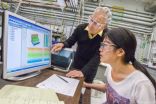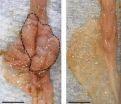(Press-News.org) Artificial photosynthesis, in which we emulate the process used by nature to capture energy from the sun and convert it into electrochemical energy, is expected to be a major asset in any sustainable energy portfolio for the future. Artificial photosynthesis offers the promise of producing liquid fuels that are renewable and can be used without exacerbating global climate change. A key to realizing commercial-scale artificial photosynthesis technology is the development of electrocatalysts that can efficiently and economically carry out water oxidation reaction that is critical to the process. Heinz Frei, a chemist with Berkeley Lab's Physical Biosciences Division, has been at the forefront of this research effort. His latest results represent an important step forward.
"The oxidation of water to molecular oxygen is a four-electron process involving multiple steps," Frei says. "We've obtained the first direct, temporally resolved observation of two intermediate steps in water oxidation using an Earth-abundant solid catalyst, cobalt oxide, that allowed us to identify the kinetic bottlenecks. With this knowledge, we can devise and design improvements on the cobalt oxide catalyst and its support environment to partially or completely remove these bottlenecks and improve the efficiency of water oxidation."
In an artificial photosynthetic system, the oxidation of water molecules into oxygen, electrons and protons (hydrogen ions) provides the electrons needed to produce liquid fuels from carbon dioxide and water. This requires a catalyst that is both efficient in its use of solar photons and fast enough to keep up with solar flux in order to avoid wasting those photons. It should also be robust and affordable on a large-scale. Five years ago, a study led by Frei identified cobalt oxide in the form of single crystal nanoparticles as an excellent candidate for meeting the challenge. However, realizing the full catalytic potential of cobalt oxide nanocrystals requires a better understanding of the individual events in the four-electron cycle of water oxidation.
To provide this understanding, Frei, working with Miao Zhang and Moreno de Respinis, used a spectroscopic technique known as rapid-scan Fourier transform infrared (FTIR) spectroscopy.
"Prior to our study, it was not known whether the catalysis, which takes place on the surface of the cobalt oxide crystallites, happens at every cobalt center on the surface at the same speed, or whether a subset of cobalt sites does most of the work while other subsets are slow or merely spectators, Frei says. "Our results show that there is a subset of fast sites where a considerable fraction of the catalysis takes place, and a subset of sites where the catalysis proceeds considerably more slowly. This discovery of these fast and slow sites and the proposed structural difference between two provides the basis for designing cobalt oxide surfaces with higher concentrations of fast sites."
Frei, Zhang and de Respinis have reported their findings in the journal Nature Chemistry in a paper titled "Time-resolved observations of water oxidation intermediates on a cobalt oxide nanoparticle catalyst."
INFORMATION:
This research was supported by the U.S. Department of Energy's Office of Science.
Every step you take
Berkeley Lab researchers identify key intermediate steps in artificial photosynthesis reaction
2014-03-04
ELSE PRESS RELEASES FROM THIS DATE:
Eliminating bacteria, changing lifestyle could lower risk in people genetically susceptible to color
2014-03-04
New York, NY— Bacteria in the gut are essential for the development of intestinal tumors in mice, according to research led by investigators from the Icahn School of Medicine at Mount Sinai. Removing the bacteria may play a critical role in reducing cancer risk, the researchers write, in the March issue of the Journal of Experimental Medicine.
Sergio A. Lira, MD, PhD, Director of the Immunology Institute, and Professor of Immunology and Medicine, and his laboratory at the Icahn School of Medicine at Mount Sinai, used a transgenic mouse model to test the hypothesis that ...
Voters using smartphones made fewer errors in mock election
2014-03-04
Voters who cast their ballots via smartphones made fewer errors than they did when voting via traditional methods in a mock election, according to new research from psychologists at Rice University.
In a first-of-its-kind study, co-author Rice Professor of Psychology Michael Byrne examined how smartphone-based voting systems can be incorporated into the current large-scale voting process. The study, "Toward More Usable Electronic Voting: Testing the Usability of a Smartphone Voting System," found that while there are no consistent differences in efficiency and perceived ...
Native American city on the Mississippi was America's first 'melting pot'
2014-03-04
CHAMPAIGN, Ill. — New evidence establishes for the first time that Cahokia, a sprawling, pre-Columbian city situated at the confluence of the Missouri and Mississippi rivers, hosted a sizable population of immigrants.
Cahokia was an early experiment in urban life, said Thomas Emerson, who led the new analysis. Emerson is Illinois state archaeologist and the director of the Illinois State Archaeological Survey at the University of Illinois.
Researchers have traditionally thought of Cahokia as a relatively homogeneous and stable population drawn from the immediate area, ...
Researchers discover how soils control atmospheric hydrogen
2014-03-04
Researchers at New Zealand's University of Otago are helping to clear up an enduring mystery regarding the composition of the Earth's atmosphere. They have discovered the microbial soil processes that help ensure that the explosive gas hydrogen remains at trace levels.
In recent decades it was found that around four-fifths of all hydrogen released into the air is rapidly removed through soil activity, but exactly what is recycling it, and how, has remained unclear.
Now, Otago scientists have shown that the soil bacterium Mycobacterium smegmatis uses two special enzymes ...
Increased intake of fish can boost good cholesterol levels
2014-03-04
Increasing the intake of fatty fish increases the number of large HDL particles, according to a recent study completed at the University of Eastern Finland. People who increased their intake of fish to a minimum of 3–4 weekly meals had more large HDL particles in their blood than people who are less frequent eaters of fish. Large HDL particles are believed to protect against cardiovascular diseases. The results were published in PLOS ONE.
The consumption of fish has long been know to be beneficial for health; however, the mechanisms by which fats and other useful nutrients ...
Liver metabolism study could help patients awaiting transplants
2014-03-04
In a new study that could help doctors extend the lives of patients awaiting liver transplants, a Rice University-led team of researchers examined the metabolic breakdown that takes place in liver cells during late-stage cirrhosis and found clues that suggest new treatments to delay liver failure.
More than 17,000 Americans are awaiting a liver transplant, and of those, about 1,500 will die this year while still waiting, according to the American Liver Foundation. The new research, which appeared online Feb. 27 in the Journal of Hepatology, suggests new treatments that ...
Homing in on cancer with a comprehensive measurement method
2014-03-04
Cancer is the second most common cause of death in Switzerland. There are many reasons why in the era of cutting-edge medicine it is still difficult to cure this disease. A tumour may, for instance, consist of different tumour cell subpopulations, each of which has its own profile and responds differ-ently to therapy – or not. Furthermore, the cancer cells and the healthy cells in the body interact and communicate with one another. How a tumour then actually develops and whether metastases form depends on which signals a tumour cell receives from its environment. With the ...
Relativity shakes a magnet
2014-03-04
The research group of Professor Jairo Sinova at the Institute of Physics at Johannes Gutenberg University Mainz (JGU), in collaboration with researchers from Prague, Cambridge, and Nottingham, have predicted and discovered a new physical phenomenon that allows to manipulate the state of a magnet by electric signals. Current technologies for writing, storing, and reading information are either charge-based or spin-based. Semiconductor flash or random access memories are prime examples among the large variety of charge-based devices. They utilize the possibility offered by ...
Researchers report on discovery to make solar power less expensive and more efficient
2014-03-04
University of Cincinnati researchers are reporting early results on a way to make solar-powered panels in lights, calculators and roofs lighter, less expensive, more flexible (therefore less breakable) and more efficient. Fei Yu, a University of Cincinnati doctoral student in materials engineering, will present new findings on boosting the power conversion efficiency of polymer solar cells on March 3, at the American Physical Society Meeting in Denver.
Yu is experimenting with adding a small fraction of graphene nanoflakes to polymer-blend bulk-heterojunction (BHJ) solar ...
New online care from dietitians helps control weight
2014-03-04
SEATTLE—A rich chocolate cake is tempting you, but where is a dietitian when you need one?
The e-Care for Heart Wellness study sought to solve this problem. In the study, Group Health patients who were overweight and had hypertension were more likely to have lost 10 pounds in six months if they had secure online access to a dietitian than if they received only information and usual care. The American Journal of Preventive Medicine published the e-Care study.
"One patient said, 'It's like having a dietitian in your pocket,'" said Beverly B. Green, MD, MPH, a family ...
LAST 30 PRESS RELEASES:
This self-powered eye tracker harnesses energy from blinking and is as comfortable as everyday glasses
Adverse prenatal exposures linked to higher rates of mental health issues, brain changes in adolescents
Restoring mitochondria shows promise for treating chronic nerve pain
Nature study identifies a molecular switch that controls transitions between single-celled and multicellular forms
USU chemists' CRISPR discovery could lead to single diagnostic test for COVID, flu, RSV
Early hominins from Morocco reveal an African lineage near the root of Homo sapiens
Small chimps, big risks: What chimps show us about our own behavior
We finally know how the most common types of planets are created
Thirty-year risk of cardiovascular disease among healthy women according to clinical thresholds of lipoprotein(a)
Yoga for opioid withdrawal and autonomic regulation
Gene therapy ‘switch’ may offer non-addictive pain relief
Study shows your genes determine how fast your DNA mutates with age
Common brain parasite can infect your immune cells. Here's why that's probably OK
International experts connect infections and aging through cellular senescence
An AI–DFT integrated framework accelerates materials discovery and design
Twist to reshape, shift to transform: Bilayer structure enables multifunctional imaging
CUNY Graduate Center and its academic partners awarded more than $1M by Google.org to advance statewide AI education through the Empire AI consortium
Mount Sinai Health system receives $8.5 million NIH grant renewal to advance research on long-term outcomes in children with congenital heart disease
Researchers develop treatment for advanced prostate cancer that could eliminate severe side effects
Keck Medicine of USC names Christian Pass chief financial officer
Inflatable fabric robotic arm picks apples
MD Anderson and SOPHiA GENETICS announce strategic collaboration to accelerate AI-driven precision oncology
Oil residues can travel over 5,000 miles on ocean debris, study finds
Korea University researchers discover that cholesterol-lowering drug can overcome chemotherapy resistance in triple-negative breast cancer
Ushikuvirus: A newly discovered giant virus may offer clues to the origin of life
Boosting the cell’s own cleanup
Movement matters: Light activity led to better survival in diabetes, heart, kidney disease
Method developed to identify best treatment combinations for glioblastoma based on unique cellular targets
Self-guided behavioral app helps children with epilepsy sleep earlier
Higher consumption of food preservatives is associated with an increased risk of type 2 diabetes
[Press-News.org] Every step you takeBerkeley Lab researchers identify key intermediate steps in artificial photosynthesis reaction






